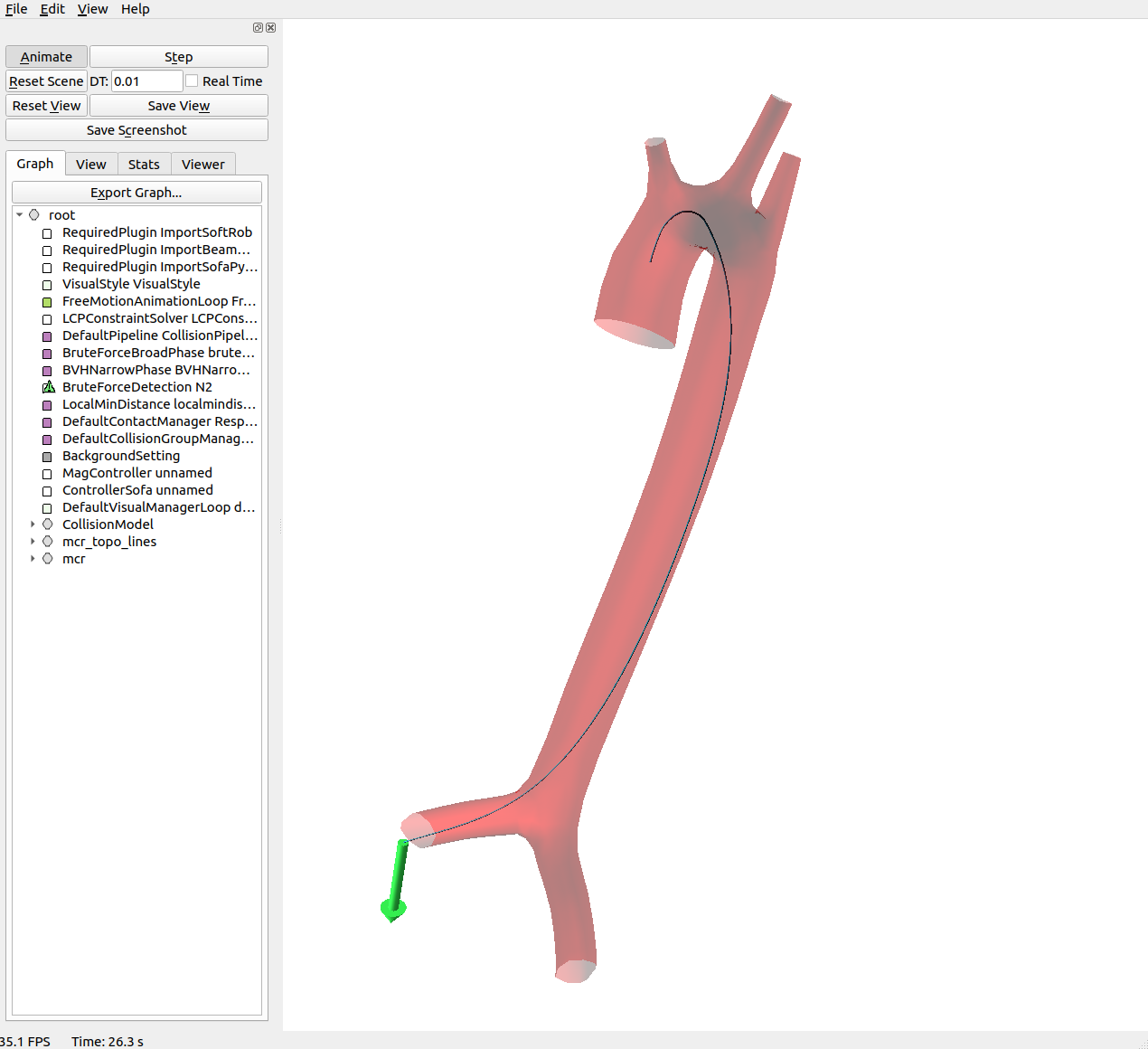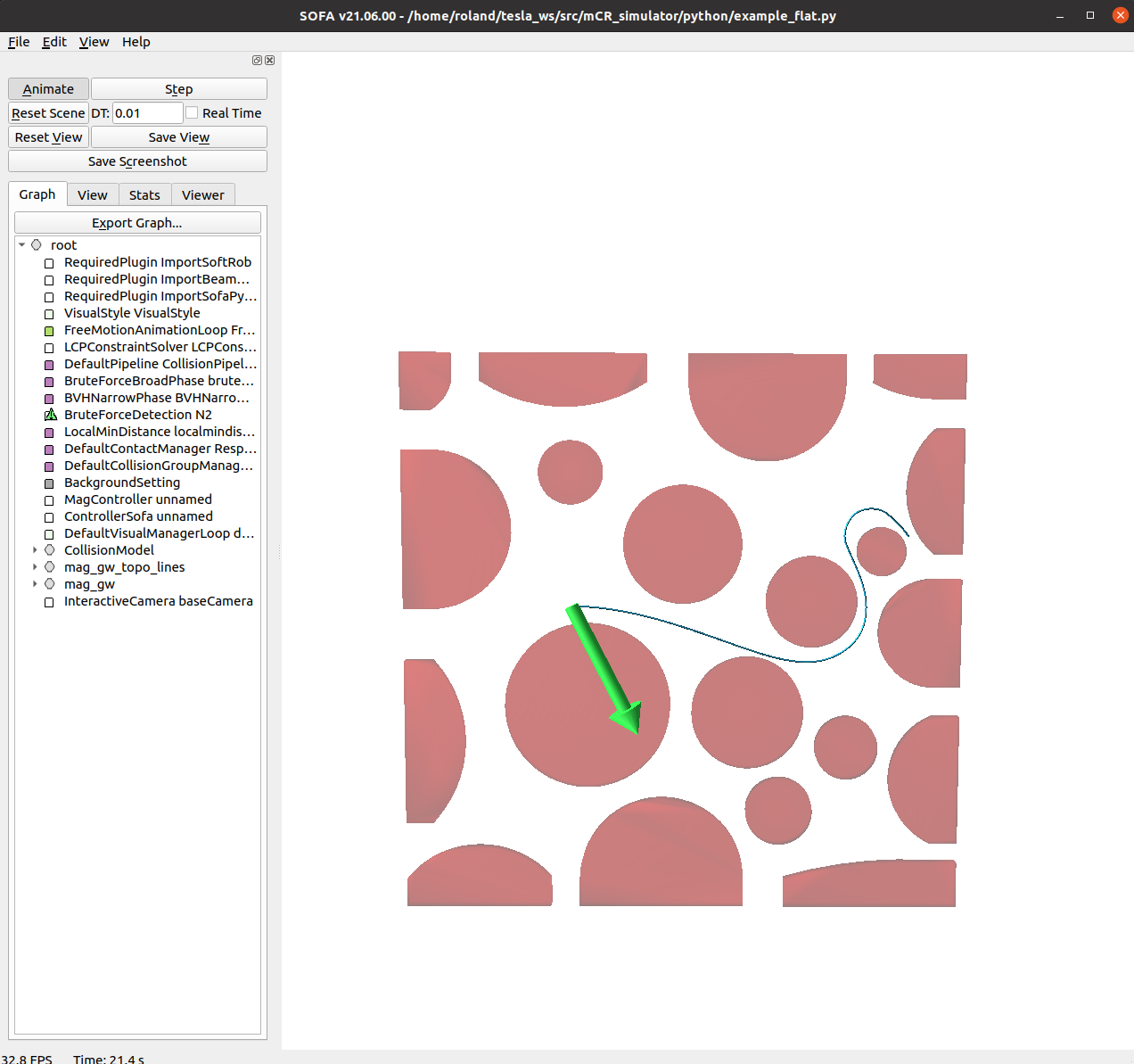Roland Dreyfus, Quentin Boehler, Bradley J. Nelson
The magnetic continuum robot (m-CR) simulator is an object-oriented Python implementation of SOFA to simulate magnetically actuated continuum robots. The package interfaces magnetic field models with the SOFA simulated mechanical model of the continuum robot. SOFA (Simulation Open Framework Architecture) is an open-source framework primarily targeted at real-time simulation, with an emphasis on medical simulation.

|

|
This requires Ubuntu 20.04 with Python 3.
Follow the instructions here to build SOFA with Linux.
This code was tested with v.21.12 for SOFA and the external plugins.
Build SOFA and include the following external plugins using these instructions:
Make sure to use the same version for SOFA and the plugins (these instructions were tested with v21.12), and to load these plugins in the plugin manager of runSofa.
In CMake GUI, make sure to configure the path to the external plugins in the CMake variable SOFA_EXTERNAL_DIRECTORIES, and check the following boxes:
PLUGIN_BEAMADAPTERPLUGIN_SOFAIMPLICITFIELDPLUGIN_SOFADISTANCEGRIDPLUGIN_PLUGINEXAMPLEPLUGIN_STLIBPLUGIN_SOFTROBOTSSOFA_FETCH_SOFAPYTHON3(make sure to follow these guidelines for a proper installation of SofaPython3, and make sure you load SofaPython3 via the plugin manager of runSofa)
Make sure the box for PLUGIN_SOFAPYTHON is unchecked.
This repository has the following dependencies:
- mag_manip: toolbox for electromagnetic navigation systems (eMNS) modelling.
For installing mag_manip using pip:
pip install mag-manip
- Open a terminal and go to the
/bindirectory of SOFA
./runSofa
- File/Open to open the scene (extentions *.scn or *.pyscn)
- Press "Animate" to start the scene
More information on how to use SOFA here.
-
Insertion/retraction
- CTRL + up/down: insertion/retraction of the m-CR
-
Magnetic field
- CTRL + I/K: inclination angle
- CTRL + J/L: azimuth angle
An example of how to build an m-CR simulation scene can be found in
Below is a step-by-step explanation of how to build an m-CR simulation scene. The explanation is based on example_aortic_arch.py.
Import the mcr_simulation modules
from mcr_simulation import \
mcr_environment, mcr_instrument, mcr_emns, mcr_simulator, \
mcr_controller_sofa, mcr_magnetLoad or define the simulation parameters:
# Calibration file for eMNS
cal_path = '../../calib/Navion_2_Calibration_24-02-2020.yaml'
# Parameters instrument
young_modulus_body = 170e6 # (Pa)
young_modulus_tip = 21e6 # (Pa)
length_body = 0.5 # (m)
length_tip = 0.034 # (m)
outer_diam = 0.00133 # (m)
inner_diam = 0.0008 # (m)
length_init = .35
# Parameters environment
environment_stl = '../../mesh/J2-Naviworks.stl'
# Parameter magnet
magnet_length = 4e-3 # (m)
magnet_id = 0.86e-3 # (m)
magnet_od = 1.33e-3 # (m)
magnet_remanence = 1.45 # (T)
# Parameter for beams
nume_nodes_viz = 600
num_elem_body = 30
num_elem_tip = 3
# Transforms
# Sofa sim frame in eMNS
# Transforms (translation , quat)
T_sim_mns = [
0., 0., 0.,
0., 0., 0., 1]
# Environment in sofa sim frame
T_env_sim = [
0., -0.45, 0.,
-0.7071068, 0, 0, 0.7071068]
# Starting pose sofa_sim frame
T_start_sim = [
-.075, -.001, -.020, 0.,
-0.3826834, 0., 0.9238795]To build an m-CR simulation, start by creating the SOFA scene:
def createScene(root_node):
''' Build SOFA scene '''Add the simulation physics and solver. The mcr_simulator object defines the solver settings and adds gravity, friction, constraints, etc.
# simulator
simulator = mcr_simulator.Simulator(
root_node=root_node)Define the electromagnetic navigation system. The mcr_emns class uses mag_manip to model the magnetic field and provides methods to compute currents from magnetic fields (backward model) and magnetic fields from currents (forward model).
# eMNS
navion = mcr_emns.EMNS(
name='Navion',
calibration_path=cal_path)Add the environment. The mcr_environment object adds the mechanical, collision and visual models of the envirnoment (e.g. anatomical model or collision objects) to the SOFA scene.
# environment
environment = mcr_environment.Environment(
root_node=root_node,
environment_stl=environment_stl,
name='aortic_arch',
T_env_sim=T_env_sim,
flip_normals=True,
color=[1., 0., 0., 0.3])Define the magnets that are embedded in the m-CR body. A magnet object can be created with the mcr_magnet class.
# magnet
magnet = mcr_magnet.Magnet(
length=magnet_length,
outer_diam=magnet_od,
inner_diam=magnet_id,
remanence=magnet_remanence)The magnetic elements of the instrument are defined by a list with the same length as the proximal section of the instrument num_elem_tip. The magnets should be stored at the index of the instrument element that is magnetic.
# magnets on both ends of flexible segment
magnets = [0. for i in range(num_elem_tip)]
magnets[0] = magnet
magnets[-1] = magnetCreate the magnetic instrument object. The mcr_instrument class adds the mechanical, collision, and visual model to the SOFA scene.
# instrument
instrument = mcr_instrument.Instrument(
name='mcr',
root_node=root_node,
length_body=length_body,
length_tip=length_tip,
outer_diam=outer_diam,
inner_diam=inner_diam,
young_modulus_body=young_modulus_body,
young_modulus_tip=young_modulus_tip,
magnets=magnets,
num_elem_body=num_elem_body,
num_elem_tip=num_elem_tip,
nume_nodes_viz=nume_nodes_viz,
T_start_sim=T_start_sim,
color=[.2, .8, 1., 1.]
)Create the controller. The controller interfaces with the SOFA controller and with the magnetic field controller. On keyboard events, the desired magnetic field and insertion inputs are sent to the controllers.
# sofa-based controller
controller_sofa = mcr_controller_sofa.ControllerSofa(
root_node=root_node,
e_mns=navion,
instrument=instrument,
length_init=length_init,
T_sim_mns=T_sim_mns,
)
root_node.addObject(controller_sofa)Data processing and figure generation was done in jupiter notebook.
To launch Jupyter open a terminal, go to the directory ral_22_sofa_magnetic, and launch jupyter notebook. This will open a web browser window.
jupyter notebook notebook/ral_2022_mCR_data_viz.ipynbTo run the tracker open a terminal, go to the directory ral_22_sofa_magnetic, and run the python script:
python3 python/instrument_tracker.py -v video/MVI_9976.mp4
Contact: Roland Dreyfus: dreyfusr@ethz.ch, Quentin Boehler: qboehler@ethz.ch